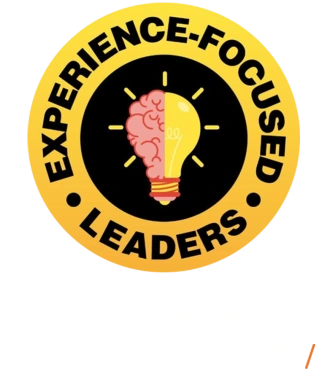Listen to the Podcast Episode on Your Favorite Platform

.svg.png)

Linking Employee and Customer Experiences for Growth
.png)
Companies that focus on both employee and customer experience in parallel and see the synergies and the linkages have incredible results: stock prices increase, retention of customers and employees goes up. There's just so much goodness from having a focus on helping employees feel engaged and important. Helping the customers feel like they're getting a lot of value and that they're an important part of the company as well. (Mary Poppen)
(00:00-08:15)
Mary Poppen emphasizes that organizations often overlook the significance of both employee and customer experiences, despite the immense benefits of focusing on both. Companies that prioritize both experiences simultaneously see increased stock prices and higher retention rates for both customers and employees.
The speakers discuss how unhappy employees can negatively impact customer satisfaction and business growth. Mary suggests starting by bringing HR and customer leaders together to understand the experiences of employees delivering customer service. By involving all relevant teams, including product creators, in understanding customer needs and delivering value, businesses can foster a culture of collaboration and continuous improvement.
They also explore the importance of humility and feedback loops in product development, emphasizing the need for all departments to focus on customer success rather than simply answering questions. Successful organizations create a culture where everyone is aligned with the goal of delivering value to customers and improving the overall experience.
.png)
Fostering Collaboration and Empowerment
.png)
If you can build that shared mindset around ownership and accountability and help people understand how they need to work with others in the organization to deliver the outcome, it becomes a “help me — help you” mindset instead of “this is my role and this is what I deliver”. (Mary Poppen)
(08:15-17:18)
Mary highlights the common issue of departments operating in silos, leading to a reactive culture where individuals may dismiss tasks outside their designated roles with the refrain, "That's not my job."
She emphasizes the necessity of cultivating a shared vision among employees, focusing on the organization's mission and its impact on customers. By helping individuals understand their role in achieving this mission and recognizing the interconnectedness of their work with others, organizations can foster a culture of accountability and collaboration.
The conversation delves into practical strategies for creating customer-centric processes and empowering employees to take ownership of customer success. Mary emphasizes the importance of leadership in defining clear processes and providing the necessary resources and tools for employees to deliver exceptional customer experiences.
Furthermore, the speakers discuss the grassroots initiative that employees can take to drive positive change within their organizations, from modeling better processes to raising challenges and proposing solutions.
Alex shares his experiences in leading teams across different cultures and geographies, stressing the importance of empowering individuals to take ownership and make decisions confidently.
.png)

Creating a Culture of Transparency and Empowerment
.png)
It's really important to follow through and for leadership to be transparent, over-communicate and give that sense of “You're in it with us, we're all in it together, so your voice matters”. (Mary Poppen)
(17:18-23:44)
Mary highlights the need for organizations to be transparent about their priorities and to encourage employees to share their ideas freely, creating an environment where everyone feels heard and valued.
She emphasizes the significance of following through on promises of openness and ensuring that employees feel safe to voice their opinions without fear of repercussion. Mary shares a successful example from her past experience where employees were encouraged to suggest cost-saving measures, resulting in innovative solutions that benefited the company.
Furthermore, Mary explores the importance of feedback loops, where leaders acknowledge employees' contributions and provide transparent explanations when certain ideas cannot be implemented. Mary suggests that leaders should express gratitude for employees' input while also being transparent about how ideas align with the company's vision and priorities.
Alex reflects on personal challenges in balancing active listening with problem-solving and offers insights into navigating these situations. Mary advises leaders to acknowledge their own limitations and to encourage open dialogue with their teams, empowering employees to speak up when they feel their voices aren't being heard.
.png)
Embracing Mistakes and Balancing Customer Needs
.png)
If you have a better idea, let's explore it. And if you happen to go outside of this process and it doesn't work, let's regroup, debrief, learn from it and just not do it again, right? So it's that feeling like they're not going to get in trouble but we're going to look at it as a learning opportunity. (Mary Poppen)
(23:44-31:06)
The speakers talk about the need for leaders to acknowledge their own fallibility and create an environment where team members feel safe to admit errors and explore new ideas.
Alex emphasizes the importance of debriefing and learning from mistakes without resorting to blame. He encourages his team to openly discuss failures and collaborate on finding solutions, fostering a culture where everyone feels empowered to contribute.
Mary expands on the concept of intelligent risk-taking, emphasizing the importance of defining boundaries and providing employees with the freedom to explore innovative ideas within those parameters. She underscores the value of learning from experimentation and adapting strategies based on feedback and outcomes.
The conversation then shifts to the challenge of balancing resources and priorities when serving different types of customers. Alex raises the dilemma of pleasing all customers while also prioritizing those with the greatest impact on the business.
Mary offers insights into developing scalable solutions to support smaller customers while also providing personalized support to larger clients. She emphasizes the need for clear communication and strategic decision-making to ensure that resources are allocated effectively.
.png)

Introducing customer segmentation and automation
.png)
The challenging customers are the ones that are pushing the boundaries of what you've built. They're mature, they're forward-thinking and they're ready. They need your solution today but they're using it at kind of maximum complexity. (Mary Poppen)
(31:06-38:12)
Mary discusses the transition from a high-touch, hands-on approach to a more segmented and automated model as companies expand. She emphasizes the importance of understanding customer success metrics and tailoring services to meet varying customer needs.
As companies grow, Mary explains the necessity of introducing customer segmentation and automation to streamline processes and enhance scalability. It's important to communicate with employees about these changes and ensuring they understand the benefits for both customers and the company.
Furthermore, Mary addresses the issue of customer selection, acknowledging that not every customer is the right fit for every business or product. She talks about the importance of nurturing customer relationships and evolving with them over time, while also recognizing the need to prioritize resources for customers who align best with the company's goals and values.
.png)
Evolution of Customer Experience and Content Personalization
.png)
I think the technology and the appetite for data, and using that data to gain insights and start making data-driven decisions, have been probably the biggest evolutions that I've seen. Whether it's in customer experience, employee experience or other user experience, AI has really been game-changing. It is starting to look at relationships and patterns in data, with new technologies behind the scenes, raising the most relevant insights and information. (Mary Poppen)
(38:12-45:53)
The speakers talk about customer maturity levels and how important it is to align visions for ensuring successful partnerships. Mary highlights the early identification of misalignments to prevent challenges and foster better relationships.
They discuss the transformation of customer support resources from traditional formats like PDF handbooks to more interactive and scalable content solutions. Mary refers to this shift as "personalization at scale," where businesses can tailor content based on individual needs, roles and levels of maturity.
Mary emphasizes the power of technology, particularly AI, in analyzing data and uncovering valuable insights to drive data-driven decisions. She predicts that the integration of AI and advanced content platforms will revolutionize customer and employee experiences, offering personalized solutions and enhancing overall satisfaction.
.png)

Creating Customer-Centric Experiences: Insights from Mary Poppen
.png)
Starting somewhere is really important. You don't have to be 100% ready to roll out results and new initiatives. You get 80% there and then roll it out. Too often, people get into analysis paralysis instead of taking action. Taking any action and making a step forward is better than trying to come up with the perfect plan. It's never going to be perfect. It's always going to be changing. So take action as soon as possible. (Mary Poppen)
(45:53-50:47)
Mary emphasizes the power of personalized content, stressing the need to move beyond generic messaging and truly connect with customers on a personal level. She shares her journey of writing a book on customer experience, revealing how she found inspiration in weaving fictional characters into her narrative to make complex ideas more relatable.
Beyond business, Mary offers invaluable advice for students and professionals, urging them to embrace action over perfection. She encourages listeners to start somewhere, even if they're not 100% ready, highlighting the importance of progress and learning along the way.
.png)
Check the the episode's Transcript (AI-generated) HERE.
Other Episodes

Godard Abel | CEO of G2
S 01 | Ep 6 Where You Go for Software: Reach Your Peak


Dean Stocker | CEO of Alteryx
S 01 | Ep 8 Turning Your Customers Into Your Biggest Champions


Peter Fader | Co-Founder of ThetaCLV
S 01 | Ep 10 Turning Your Marketing Into Dollars

Author

Experience-focused Leaders is the #1 Multimedia Podcast! We talk to senior business & tech leaders about the experiences that move forward organizations, customers and society at large. True to form, we mix audio, video, web and eBook formats to turn these authentic conversations into personalized nuggets you'll remember & use.



.png)
